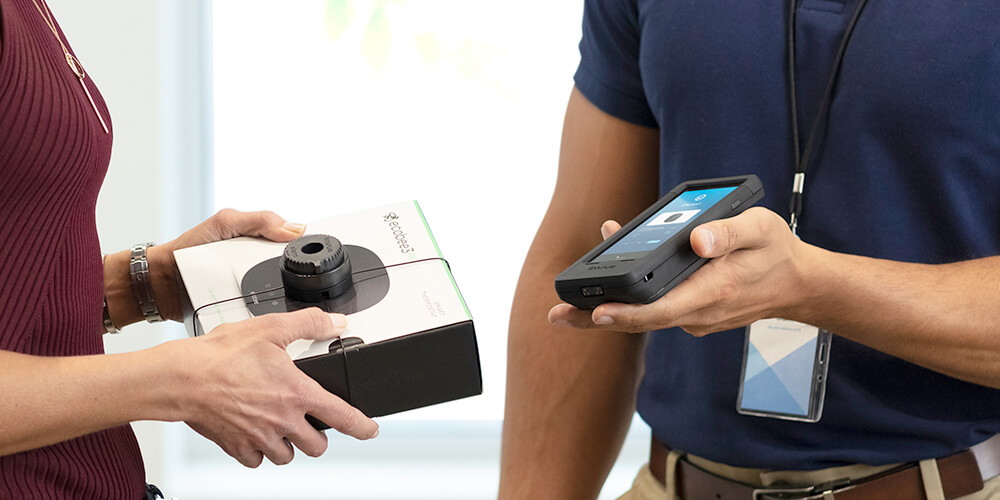What to look for in your mPOS
This year, mobile Point of Sale (mPOS) is among the retail trends experiencing a rapid rise. Scalable, affordable, and versatile, it allows retailers to cut time that customers spend in the queue while facilitating an improved customer experience.
But the reality is, not all mPOS is created equal. So what should retailers look for when it comes to selecting a mobile Point of Sale?
What is mPOS? – a definition
Google the search term mPOS and a wealth of information appears, but the definition of exactly what mPOS is can vary greatly.
In its truest form, mobile Point of Sale replaces the traditional, static, legacy Point of Sale using a handheld device that is most often a tablet but can also be a mobile phone.
This device draws on mPOS software (i.e. an app) to function as a Point of Sale. The software is Cloud-based and includes features like available stock, pricing, sales history, and more.
The tablet then connects wirelessly to additional hardware such as barcode scanners, cash drawers, and card payment processors to allow full functionality as a Point of Sale.
Equipment required
mPOS requires an investment in both hardware and software, but the purchase of both tends to be much more affordable and flexible than traditional legacy POS.
Software is often available as either a monthly subscription and/or commission on sales, with prices varying depending on the number of users.
Equipment list
- Mobile tablet – such as an iPad, Samsung Galaxy Tab, Microsoft Surface Go etc.
- Software – There are a wealth of options available, with some of the most renowned retail mPOS apps including Square, Shopify, ShopKeep, and LightSpeed
- Payment processor (EFTPOS machine) – This is the hardware that allows retailers to process card and digital wallet payments. It is generally available from your bank (for a fee) or via a third-party provider. There are some in-app software payment options that basically treat the transaction as an online payment or “Card Not Present”, but these attract much higher transaction fees and are not economically viable for businesses doing even moderate amounts of transactions.
- Cash drawer – Cash drawers usually connect wirelessly using BlueTooth
- Barcode scanner (if required) – again, this can be connected wirelessly
- Tablet stand – To protect the device and also facilitate mobility
So, when selecting your mPOS, what should you consider?
Mobile
The major drawcard of mPOS is its mobility, allowing retailers to take the checkout to the customer and slash time spent in the queue. It also enables an uplift in sales and customer service by allowing the sales associate to never leave the customers side for the entire sales process, ensuring that the customer has one single continuous “Point of Interaction”.
However, there’s a major difference between a Point of Sale that is tablet-based yet static and a truly mobile solution that can go wherever the customer does.
True mPOS is a solution that retail associates can carry all day, use on the floor, and which facilitates payment processing as well as the standard functions of a Point of Sale.
Flexible

In a similar vein, true mPOS is flexible. The combination of a mobile device and payment processing technology is equally suited to use as a traditional register as it is to process sales on the shop floor, in pop-up outlets or at the point of curbside pick-up, or click and collect.
Agnostic
There are numerous mPOS solutions which require a retailer to commit to a specific tablet paired with a specific payment processor, which comes with very specific fees.
A more viable solution is an agnostic option, which allows the retailer to pair the device of their choice with the payment processor of their choice in a bid to develop an mPOS solution that best suits their enterprise.
Scalable
Featured product: NE360T Tablet Solution
By nature, mPOS should be scalable, which means retailers should be able to add registers when required simply by purchasing additional tablets and adding further users to the app. This is worth considering when retailers select their software. Will the app allow them to add users easily in the future?
Introducing NE360
InVue NE360 mPOS Terminal Centre is the most flexible mPOS solution on the market. Retailers can use it with any tablet, smart device, or any mobile payment terminal with any operating system (OS).
Ultimately, it allows retailers the freedom to set up the mPOS ecosystem they prefer, while accommodating the changing consumer sentiment of the modern retail landscape.
You can read more about the benefits of mPOS here, or learn more about NE360 and the simple mPOS solution it offers retailers here
